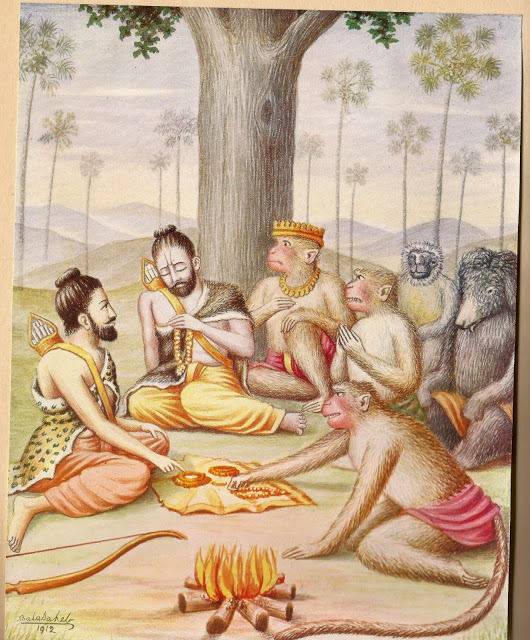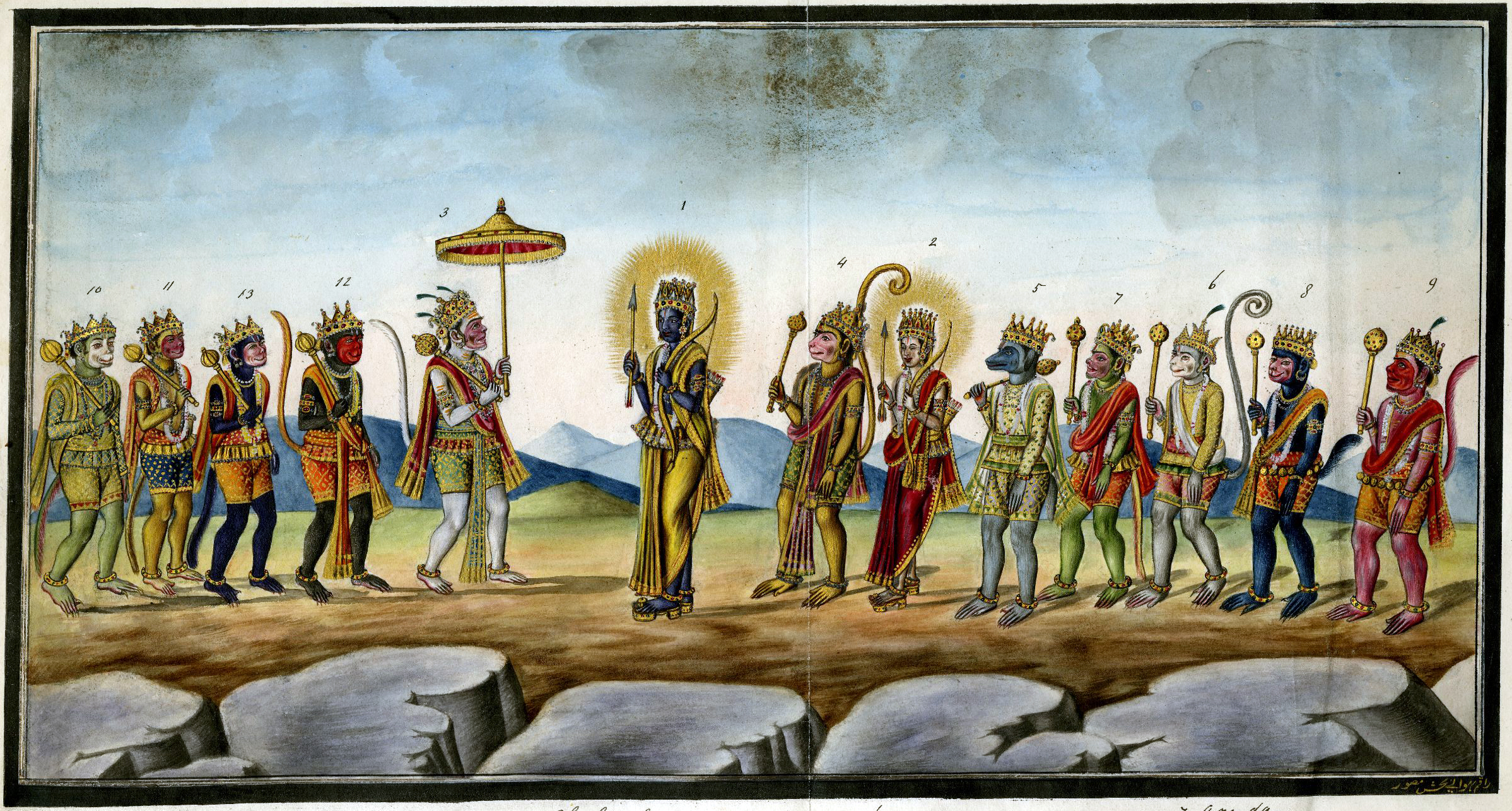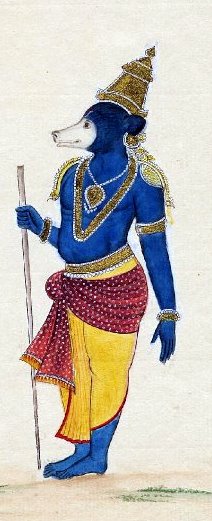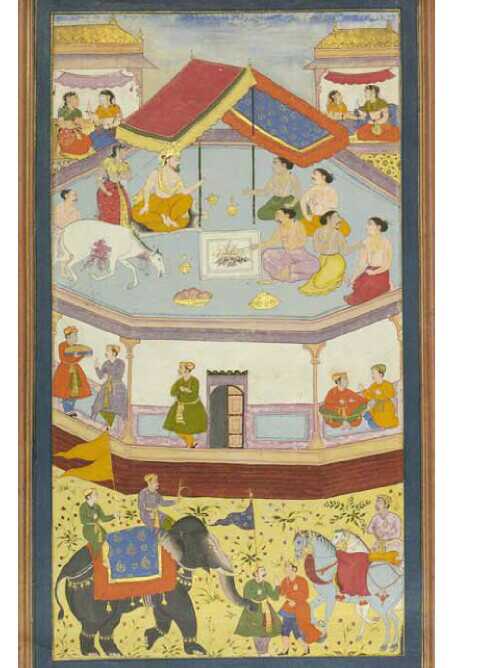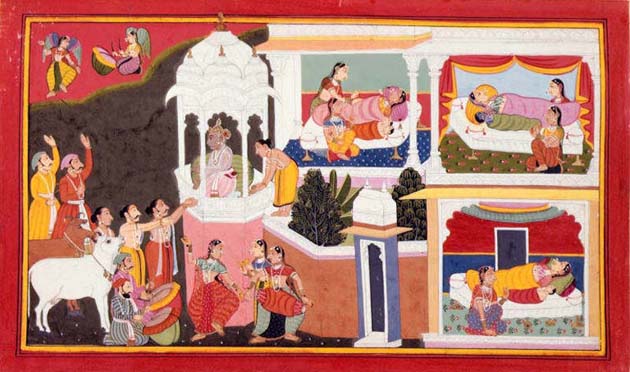|
Sugreev
''This character is about the vanara, in the Ramayana.'' Sugriva ( sa, सुग्रीव, , ) is a character In the ancient Indian epic Ramayana. He is the younger brother of Vali, whom he succeeded as ruler of the vanara kingdom of Kishkindha. Rumā is his wife. He is a son of Surya, the Hindu deity of the sun. As the king of the vanaras, Sugriva aided Rama in his quest to liberate his wife Sita from captivity at the hands of the rakshasa king Ravana. Nomenclature He is also known as jv, Sugriwa, th, Su-khrip, lo, Sugeep, km, Sukhreeb, Creole: ''Soogrim'', lo, Sangkip, ta, Cukkirivan, my, Thugyeik, Sugreeva or Sugreev. Legend The story of Sugriva is part of Ramayana and in an abbreviated version, is also present in the Mahabharata. The king of Kishkindha, Vrikshraja, was a divine creature born from Brahma’s tilaka. He had the body of a human and face and tail of a monkey. He was instructed to roam the forests and kill demons. One day, Vriksharaja entered a ... [...More Info...] [...Related Items...] OR: [Wikipedia] [Google] [Baidu] |
Vali (Ramayana)
Vali ( sa, वाली, nominative singular of the stem वालिन् (''Valin'')), also known as Bali, was a king of Kishkindha in the Hindu epic Ramayana. He was the husband of Tara, the biological son of Vriksharaja, the elder brother of Sugriva, and father of Angada. He was killed by Rama, an ''avatar'' of Vishnu. Vali was invincible during the''Treta Yuga''. Vali defeated some great warriors, only because he was blessed with the ability to obtain half the strength of his opponent. Rama killed Vali by shooting him in the chest. However, during his first attempt, Rama could not recognise between Vali and Sugriva due to their resemblance. Thus, during the next attempt, Sugriva wore a garland of red flowers and went to battle with Vali. This time, Rama could recognise Vali and shot an arrow that killed him. Early life Vali was the husband of Tara. As one myth goes, fourteen types of gem or treasure were produced from the churning of the ocean during the time of Kurma ... [...More Info...] [...Related Items...] OR: [Wikipedia] [Google] [Baidu] |
Ramayana
The ''Rāmāyana'' (; sa, रामायणम्, ) is a Sanskrit literature, Sanskrit Indian epic poetry, epic composed over a period of nearly a millennium, with scholars' estimates for the earliest stage of the text ranging from the 8th to 4th centuries BCE, and later stages extending up to the 3rd century CE. ''Ramayana'' is one of the two important epics of Hinduism, the other being the ''Mahabharata, Mahābhārata''. The epic, traditionally ascribed to the Maharishi Valmiki, narrates the life of Sita, the Princess of Janakpur, and Rama, a legendary prince of Ayodhya city in the kingdom of Kosala. The epic follows his fourteen-year exile to the forest urged by his father King Dasharatha, on the request of Rama's stepmother Kaikeyi; his travels across forests in the South Asia, Indian subcontinent with his wife Sita and brother Lakshmana, the kidnapping of Sita by Ravana – the king of Lanka, that resulted in war; and Rama's eventual return to Ayodhya to be crowned kin ... [...More Info...] [...Related Items...] OR: [Wikipedia] [Google] [Baidu] |
Vanara
In Hindu, Vanara ( sa, वानर, , forest-dwellers) are either monkeys, apes, or a race of forest-dwelling people. In the epic the ''Ramayana'', the Vanaras help Rama defeat Ravana. They are generally depicted as humanoid apes, or human-like beings. Etymology There are three main theories about the etymology of the word "Vanara": * Aiyanar suggests that ''vanara'' means "monkey" derived from the word ''vana'' ("forest"), Literally meaning "belonging to the forest" Monier-Williams says it is probably derived from ''vanar'' (lit. "wandering in the forest") and means "forest-animal" or monkey. * Devdutt Pattanaik suggests that it derives from the words ''vana'' ("forest"), and ''nara'' ("man"), thus meaning "forest man" and suggests that they may not be monkeys, which is the general meaning. * It may be derived from the words ''vav'' and ''nara'', meaning "is it a man?" (meaning "monkey") or "perhaps he is man". Identification Although the word Vanara has come to mean ... [...More Info...] [...Related Items...] OR: [Wikipedia] [Google] [Baidu] |
Kusha (Ramayana)
Kusha, also rendered Kusa (Sanskrit: कुश) and his twin brother Lava are the children of Rama and Sita in Hindu tradition. Their story is recounted in the Hindu epic ''Ramayana,'' and its other versions. Birth and childhood The first chapter of Ramayana, ''Balakanda'' mentioned Valmiki narrating the Ramayana to his disciples, Lava and Kusha. But their birth and childhood is mentioned in the last chapter ''Uttara Kanda,'' which is not believed to be the original work of Valmiki. According to the legend, a pregnant queen Sita leaves the kingdom of Ayodhya when she learns that the citizens were suspicious when a washerman of Ayodhya questioned Sita's fidelity. She then took refuge in the ashram of the sage Valmiki located on the banks of the Tamsa River. Sita gave birth to twin sons, Lava and Kusha, at the ashram. They were educated and trained in military skills under the tutelage of Valmiki, and also learned the story of Rama. Ashvamedha Yajna During an Ashvamedha Yajn ... [...More Info...] [...Related Items...] OR: [Wikipedia] [Google] [Baidu] |
Lava (Ramayana)
Lava ( sa, लव) and his twin brother Kusha, are the children of Rama and Sita in Hindu tradition. Their story is recounted in the Hindu epic, ''Ramayana'' and its other versions. He is said to have a whitish golden complexion like their mother, while Kusha had a blackish complexion like their father. Birth and childhood The first chapter of Ramayana, ''Balakanda,'' mentioned Valmiki narrating the Ramayana to his disciples, Lava and Kusha. But their birth and childhood story is mentioned in the last chapter '''Uttara Kanda which is not believed to be the original work of Valmiki. According to the legend, Sita banished herself from the kingdom due to the gossip of the kingdom folk about her sanctity. She chose self-exile and took refuge in the ashram of Valmiki located on the banks of the Tamsa river. Lava and Kusha were born at the ashram and were educated and trained in military skills under the teachings of Sage Valmiki. In which the time they had also learned the stor ... [...More Info...] [...Related Items...] OR: [Wikipedia] [Google] [Baidu] |
Ayodhya
Ayodhya (; ) is a city situated on the banks of holy river Saryu in the States and union territories of India, Indian state of Uttar Pradesh. Ayodhya, also known as Sāketa, Saketa, is an ancient city of India, the birthplace of Rama and setting of the great epic Ramayana. Ayodhya was once the capital of the ancient Kosala Kingdom. It has an average elevation of 93 meters (305 feet). Owing to the belief as the birthplace of Rama, Ayodhya (Awadhpuri) has been regarded as first one of the Sapta Puri, seven most important pilgrimage sites (Mokshdayini Sapt Puris) for Hindus. The early Buddhist and Jain canonical texts mention that the religious leaders Gautama Buddha and Mahavira visited and lived in the city. The Jain texts also describe it as the birthplace of five tirthankaras namely, Rishabhanatha, Ajitanatha, Abhinandananatha, Sumatinath and Anantnath, and associate it with the legendary Bharata Chakravarti. From the Gupta Empire, Gupta period onwards, several sources me ... [...More Info...] [...Related Items...] OR: [Wikipedia] [Google] [Baidu] |
Jambavantha
Jambavan (Devanagari: जाम्बवान्), also known as Jambavanta (Devanagari: जाम्बवत्), is the king of the bears in Hindu texts. He emerges out of the mouth of Brahma when the creator deity yawns. He assists the Rama avatar of Vishnu in his struggle against the rakshasa king Ravana. In the Ramayana, he helps Hanuman realise his potential, just before his famous leap over to the island of Lanka.Patricia Turner, Charles Russell Coulter. ''Dictionary of ancient deities''. 2001, page 248 Jambavan was present at the Churning of the Ocean, and is supposed to have circled Vamana 21 times in a single leap, when he was acquiring the three worlds from Mahabali. Jambavan, together with Parashurama and Hanuman, is considered to be one of the few to have been present for both the Rama and the Krishna avataras. His daughter Jambavati was married to Krishna. Nomenclature Jambavan is also known as: * Jambavantan * Jambavanta (জাম্বৱন্ত, Assam ... [...More Info...] [...Related Items...] OR: [Wikipedia] [Google] [Baidu] |
Ashvamedha
The Ashvamedha ( sa, अश्वमेध, aśvamedha, translit-std=IAST) was a horse sacrifice ritual followed by the Śrauta tradition of Vedic religion. It was used by ancient Indian kings to prove their imperial sovereignty: a horse accompanied by the king's warriors would be released to wander for a year. In the territory traversed by the horse, any rival could dispute the king's authority by challenging the warriors accompanying it. After one year, if no enemy had managed to kill or capture the horse, the animal would be guided back to the king's capital. It would be then sacrificed, and the king would be declared as an undisputed sovereign. The best-known text describing the sacrifice is the ''Ashvamedhika Parva'' ( sa, अश्वमेध पर्व), or the "Book of Horse Sacrifice," the fourteenth of eighteen books of the Indian epic poem ''Mahabharata''. Krishna and Vyasa advise King Yudhishthira to perform the sacrifice, which is described at great length. Th ... [...More Info...] [...Related Items...] OR: [Wikipedia] [Google] [Baidu] |
Vasistha
Vasishtha ( sa, वसिष्ठ, IAST: ') is one of the oldest and most revered Vedic rishis or sages, and one of the Saptarishis (seven great Rishis). Vashistha is credited as the chief author of Mandala 7 of the ''Rigveda''. Vashishtha and his family are mentioned in Rigvedic verse 10.167.4, other Rigvedic mandalas and in many Vedic texts. His ideas have been influential and he was called the first sage of the Vedanta school of Hindu philosophy by Adi Shankara. The '' Yoga Vasishtha'', ''Vasishtha Samhita'', as well as some versions of the ''Agni Purana'' and ''Vishnu Purana'' are attributed to him. He is the subject of many stories, such as him being in possession of the divine cow Kamadhenu and Nandini her child, who could grant anything to their owners. He is famous in Hindu stories for his legendary conflicts with sage Vishvamitra. In the Ramayana, he was the family priest of the Raghu dynasty and teacher of Rama and his brothers. Etymology Vasishtha is also spelled a ... [...More Info...] [...Related Items...] OR: [Wikipedia] [Google] [Baidu] |
Lakshmana
Lakshmana ( sa, लक्ष्मण, lit=the fortunate one, translit=Lakṣmaṇa), also spelled as Laxmana, is the younger brother of Rama and his loyalist in the Hindu epic ''Ramayana''. He bears the epithets of Saumitra () and Ramanuja (). He is the twin of Shatrughna. Legend Birth and marriage King Dasharatha of Ayodhya had three wives: Kausalya, Kaikeyi, and Sumitra. He performed a sacrifice to beget sons and as a result, his queens became pregnant. Lakshmana and his brother Shatrughna were born to Sumitra, while Rama and Bharata were born to Kausalya and Kaikeyi. In the Puranas, Lakshmana is described as an incarnation of Shesha, the multiple-headed naga (serpent) upon whom rests the preserver deity Vishnu, whose avatar Rama is considered to be. When sage Vishvamitra asked Rama to kill the demons in the forest, Lakshmana accompanied them and went to Mithila with them. Lakshmana was especially attached to Rama. When Rama married Sita, Lakshmana married Sita's ... [...More Info...] [...Related Items...] OR: [Wikipedia] [Google] [Baidu] |
Hanuman
Hanuman (; sa, हनुमान, ), also called Anjaneya (), is a Hindu god and a divine '' vanara'' companion of the god Rama. Hanuman is one of the central characters of the Hindu epic ''Ramayana''. He is an ardent devotee of Rama and one of the Chiranjivis. Hanuman is regarded to be the son of the wind-god Vayu, who in several stories played a direct role in Hanuman's birth, and considered to be an incarnation or son of Shiva in Shaivism. Hanuman is mentioned in several other texts, such as the epic ''Mahabharata'' and the various Puranas. Evidence of devotional worship to Hanuman is largely absent in these texts, as well as in most archeological sites. According to Philip Lutgendorf, an American Indologist, the theological significance of Hanuman and devotional dedication to him emerged about 1,000 years after the composition of the ''Ramayana'', in the 2nd millennium CE, after the arrival of Islamic rule in the Indian subcontinent.Paula Richman (2010), ''Review: Lut ... [...More Info...] [...Related Items...] OR: [Wikipedia] [Google] [Baidu] |
Killing Of Vali Monkey
Killing, Killings, or The Killing may refer to: Arts, entertainment, and media Films * ''Killing'' (film), a 2018 Japanese film * ''The Killing'' (film), a 1956 film noir directed by Stanley Kubrick Television * ''The Killing'' (Danish TV series), a police procedural drama first broadcast in 2007 * ''The Killing'' (U.S. TV series), a crime drama based on the Danish television series, first broadcast in 2011 Literature * ''Killing'' (comics), Italian photo comic series about a vicious vigilante-criminal * ''Killing'', a series of historical nonfiction books by Bill O'Reilly and Martin Dugard * "Killings" (short story), a short story by Andre Dubus * ''The Killing'' (Muchamore novel), a CHERUB series installment by Robert Muchamore * ''The Killing'', a 2012 novelization of the Danish TV series by David Hewson Music * "Killing", a song on the album '' Echoes'' by The Rapture * "Killing", a song from an untitled Korn album released in 2007 * ''The Killing'' (EP), by Hatesp ... [...More Info...] [...Related Items...] OR: [Wikipedia] [Google] [Baidu] |
